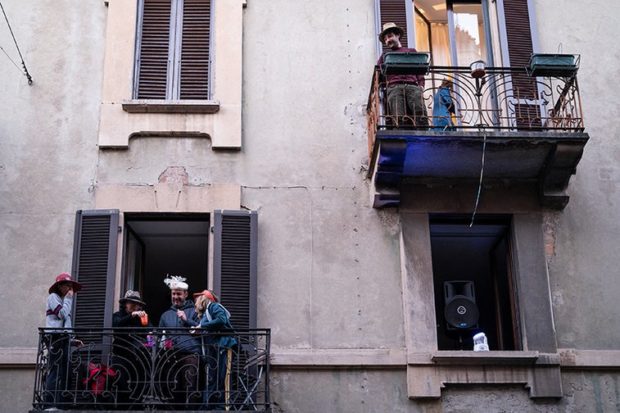You have no items in your cart. Want to get some nice things?
Go shopping
Italy has plenty of balconies. Growing up, I had one of a decent size in my family apartment; it was always kind of dirty and rarely used, but during Christmastime it would be filled with lights and decorations, thanks to the dedication of my mum – and with the constant disapproval of my environmentally-aware brother. As an Italian who lives far from home, when spring is approaching and I’m preparing dinner in my shared flat in East London, I sometimes lean on comforting stereotypes of Italian families, large and loud, sharing a meal on their modest balconies, enjoying the breeze and laughing a lot – even though we are only four, we never ate outside, and we are not as loud as you would think. After all, in Italy, balconies have been largely symbolized; on a balcony Juliet pronounced her most iconic words, Mussolini gave his speeches during the darkest times of recent history, and from a balcony indeed the Pope is now reassuring his people about the Coronavirus emergency, exhorting them to “not be afraid”. In recent times, balconies have probably been deprived of their romantic nature to assume a tactic commercial potential, as they are cheaper to build but able to increase a lot the value of a property. But the fact is, there are a lot of balconies indeed, and a brand-new movement has recently taken them over, giving them the leading role during a new people force.
I am talking here about the wave of flashmobs that originated during the first week of national lockdown for the Covid-19 pandemic, the second week of March. To show sympathy and solidarity with medical staff, patients, victims’ families, and to everyone forced to stay in quarantine for the foreseeable future, some Italian citizens started to enact various performances using balconies as privileged stages. The result was a series of collective actions, joyful and participatory, but also planned in advance, that have been spreading all over the country as fast as the virus itself – and that are now expanding to the rest of the world. Over a couple of days I received from my Italian friends at least four different flashmob schedules for the days ahead: on Wednesday people were asked to light torches on their balconies as a sign of solidarity; on Thursday to engage in collective applause for the health workers risking their lives at the forefront of the battle against the virus; on Friday to sing “Ciao Mamma”, by Jovanotti, all together, as one and the same.
The chosen mode of flashmob allows all that; described by Aristita I. Albacan as “performative acts that reconnect individuals with their environment”, flashmobs represent a moment of disruption of the everyday life and a suspension of the course of time – a particularly useful tool to intensify social relations during a time of isolation. By gathering together, but each from their own balcony, Italian communities reappropriated a public dimension that had been made unavailable by the impossibility of physically occupying actual public spaces.
In a scenario where house and health privileges have been exposed in plain sight, and some fundamental human rights have become inaccessible to the people – considering that access to care is no longer guaranteed – the possibility of restoring a sense of collectiveness holds strong emancipatory potential and the hope that, in a way or another, this crisis will pass.
The cathartic power of the Italian flashmobs, however, goes beyond the embodied experience and the message of solidarity they convey. The visual force of the balcony movements challenges the usual aesthetic of the quarantine, mostly conveyed by images of empty streets, deserted cities, and inhabitants forced to never leave their homes and far removed from society – in decadent and apocalyptic tones that actually allowed the production of some quite interesting photography. On the contrary, the nature of flashmobs is traditionally playful, fun-oriented, and exquisitely participatory; during an extended period of social distancing – and for a brief amount of time, as it typically is for flashmobs – the balcony movement invites people to fill the spaces instead of empty them, restoring in this way the efficacy of mass actions to uplift spirits and convey a sense of collectiveness, where bodies themselves become sites of resistance.
My London home does not have a balcony, so I could not dance on it. Instead, I observed the phenomenon from a distance, on my social media channels: I saw balcony dj sets, entire families singing and dancing together, communal aperitifs from one building to another, and – my personal favourite – the song “Bella Ciao” performed with a sax. As the days went by, I had the impression that the playful dimension was quickly transforming to a way more serious and patriotic tone; there was now a massive presence of Italian flags and daily singalongs of the Italian Anthem – which, by the way, can be pretty dark, and includes the lines: “Let us unite! / We are ready to die / Italy called”. Today, the spirits are changing after all; while the number of Covid-19 victims is tragically increasing, and Prime Minister Giuseppe Conte has started to firmly advise the Italian population to stay strong and united, the resistance to the virus and the very same act of staying home has become collectively considered as a civic and moral duty – a call to arms.
I cannot know for how long Italians are going to keep singing on their balconies, and whether this renewed national wave will evolve into something else. As for me, I wish we could dance together even here, in the UK – considering that probably we don’t have as many balconies. As Nandu Popu writes: “We are sad, overwhelmed with what is happening, but we step out on balconies to make music and share it with others. What if the balcony was our new exit strategy?”
About Elisa David
Elisa David is a fresh master's graduate in Art and Visual Culture. Born and raised in Turin, she is now living in London, mostly trying to avoid rush hour.




